Like nature’s own origami artists, prayer plants unfold their leaves in a mesmerizing daily dance that deserves the perfect stage in your home. You’ll discover that these tropical beauties offer endless styling possibilities, from dramatic hanging displays to eye-catching centerpieces that capture their unique personality. Whether you’re working with a single specimen or cultivating a collection, there’s an array of creative arrangements that’ll transform your living space into a dynamic botanical showcase.
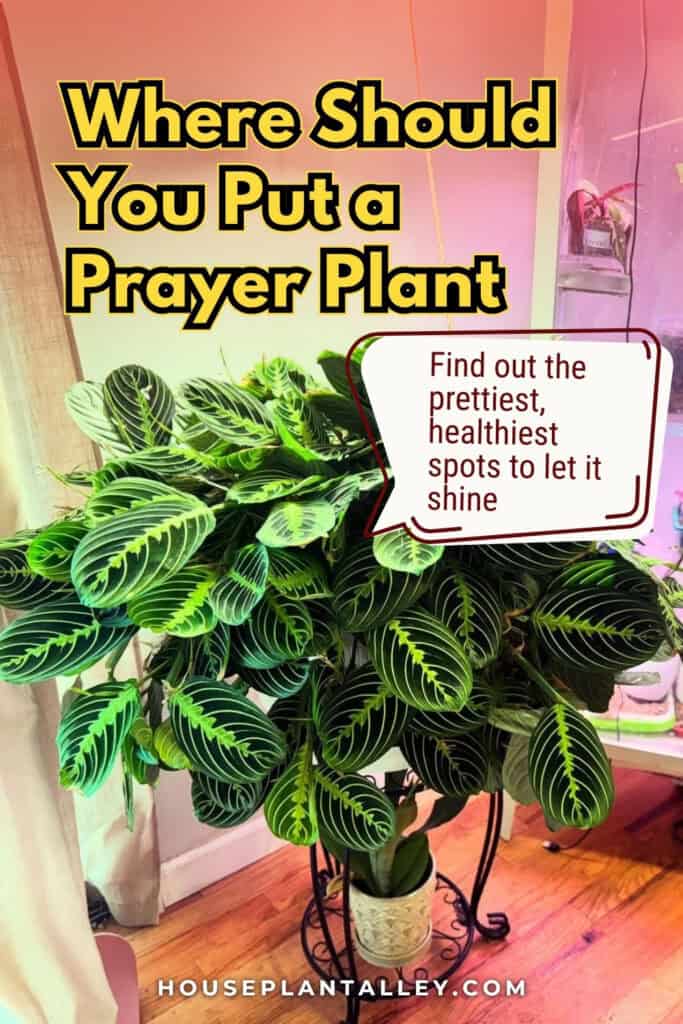
Contents
- 1 Creating Eye-Catching Hanging Displays
- 2 Mixing Prayer Plants With Other Tropical Varieties
- 3 Designing a Prayer Plant Centerpiece
- 4 Styling Prayer Plants on Floating Shelves
- 5 Using Decorative Stakes and Support Systems
- 6 Incorporating Prayer Plants Into Plant Walls
- 7 Choosing the Perfect Containers and Pots
- 8 Arranging Prayer Plants at Different Heights
- 9 Building a Prayer Plant Corner Feature
- 10 Positioning Prayer Plants Near Mirrors for Impact
Creating Eye-Catching Hanging Displays
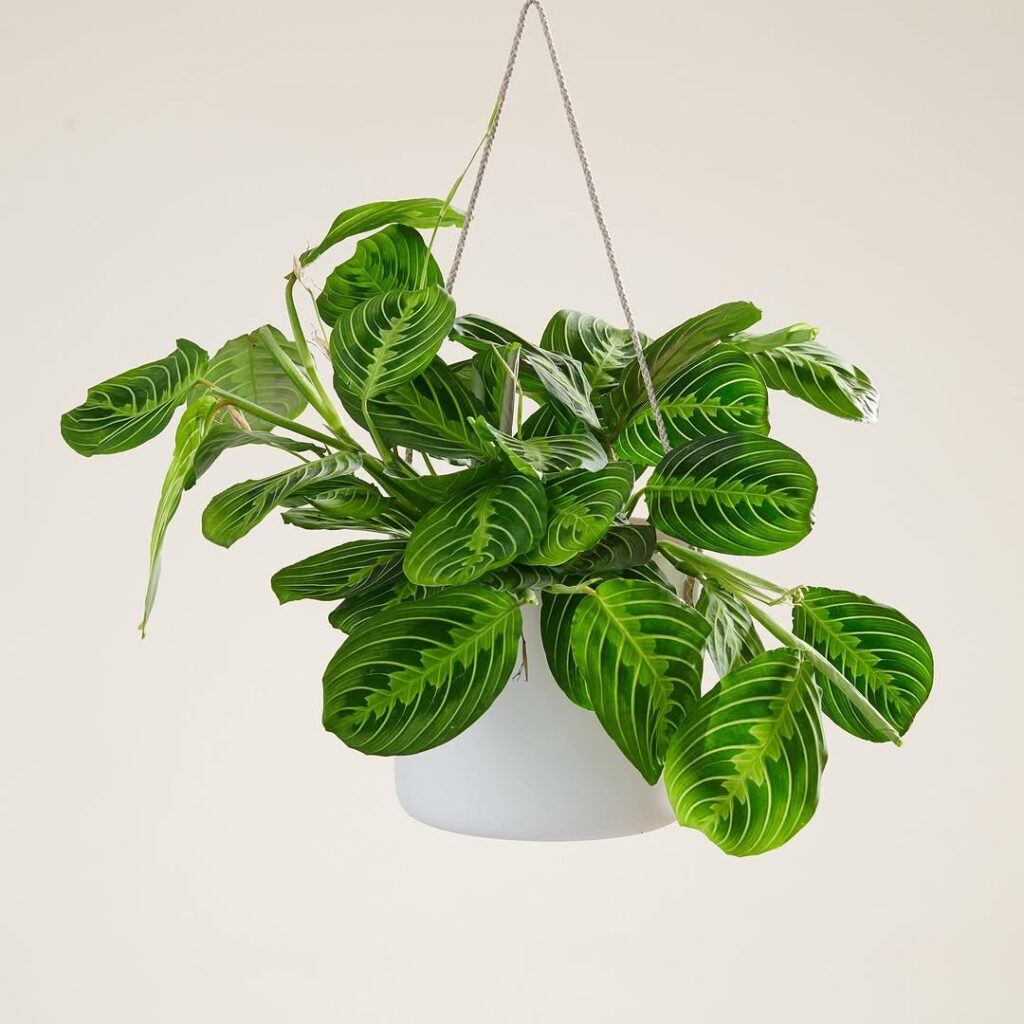
Prayer plants’ trailing leaves and dramatic foliage make them perfect candidates for hanging displays. You’ll want to position them 6-8 feet high, where their distinctive leaf movements can catch the eye throughout the day.
Choose macramé hangers with adjustable heights, ensuring your plant sits securely in a 6-inch plastic nursery pot. For best results, place the hanger 12-18 inches from an east-facing window, allowing filtered morning light to reach the foliage.
Consider clustering three hangers at staggered heights, spacing them 24 inches apart. This creates visual interest while maintaining adequate airflow between plants, preventing potential fungal issues.
Mixing Prayer Plants With Other Tropical Varieties
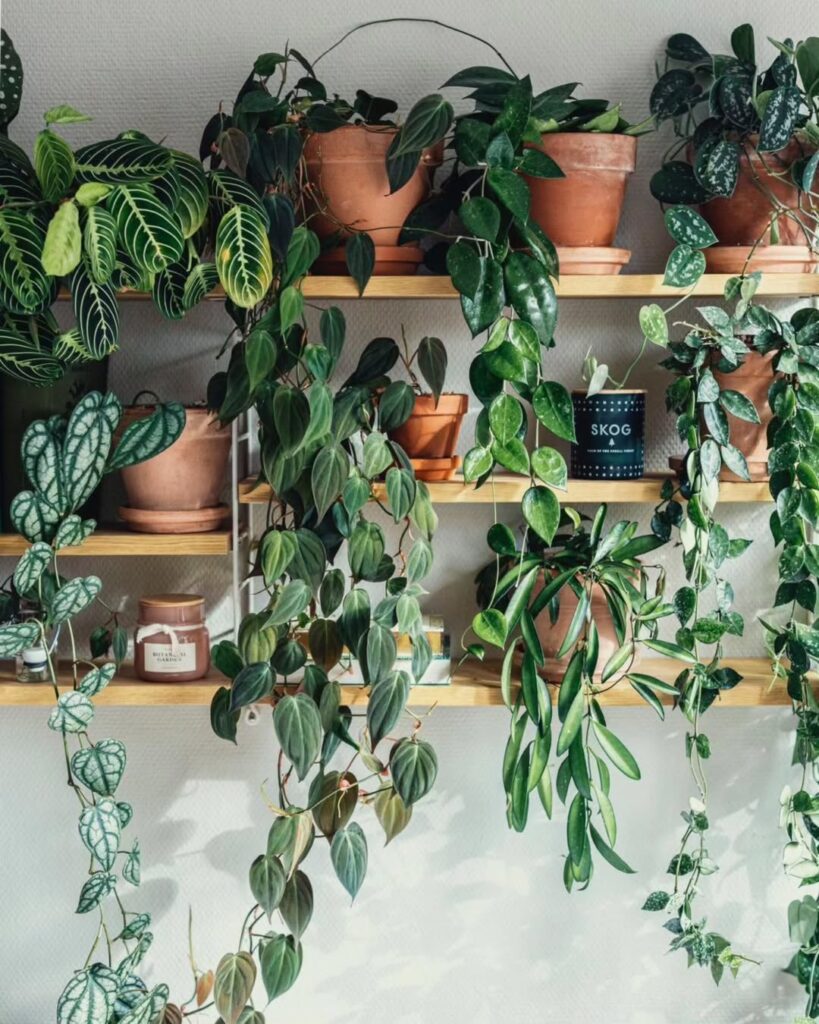
When combining prayer plants with other tropical varieties, you’ll want to start by pairing complementary foliage colors, such as matching the deep red undersides of a Maranta with the burgundy leaves of a Philodendron. Creating layered humidity zones allows you to group plants with similar moisture needs, placing prayer plants alongside ferns and calatheas for ideal growing conditions. You can enhance the visual interest by positioning taller tropical plants like Monstera deliciosa behind your prayer plants, letting their distinctive patterns create a dynamic backdrop while maintaining consistent care requirements.
Complementary Foliage Color Pairings
Creating striking visual combinations starts with pairing your Maranta’s distinctive patterns alongside other tropical plants that enhance their natural beauty. Try placing deep purple Calathea lancifolia next to your prayer plant’s burgundy-striped leaves for a rich, layered effect.
For maximum impact, pair red-veined prayer plants with solid green philodendrons or pothos, allowing the Maranta’s patterns to stand out. Silver-streaked varieties work beautifully against dark foliage plants like ZZ plants or snake plants.
Consider height variations when pairing: position 12-inch tall prayer plants in front of 24-inch arrowhead plants or umbrella plants to create engaging vertical interest without overwhelming the display.
Layered Humidity Zone Design
Because tropical plants thrive together in similar conditions, you’ll want to establish distinct humidity zones within your space. Group your prayer plants with calatheas, philodendrons, and pothos at varying heights to create a layered canopy effect.
Position taller plants like bird of paradise (5-6 feet) in the back, prayer plants (12-18 inches) in the middle, and trailing varieties near the edges. Place a humidity tray filled with pebbles and water beneath the arrangement, maintaining 60-70% humidity.
For ideal results, cluster 3-5 plants per humidity zone, spacing them 6-8 inches apart to allow proper air circulation while sharing moisture.
Designing a Prayer Plant Centerpiece
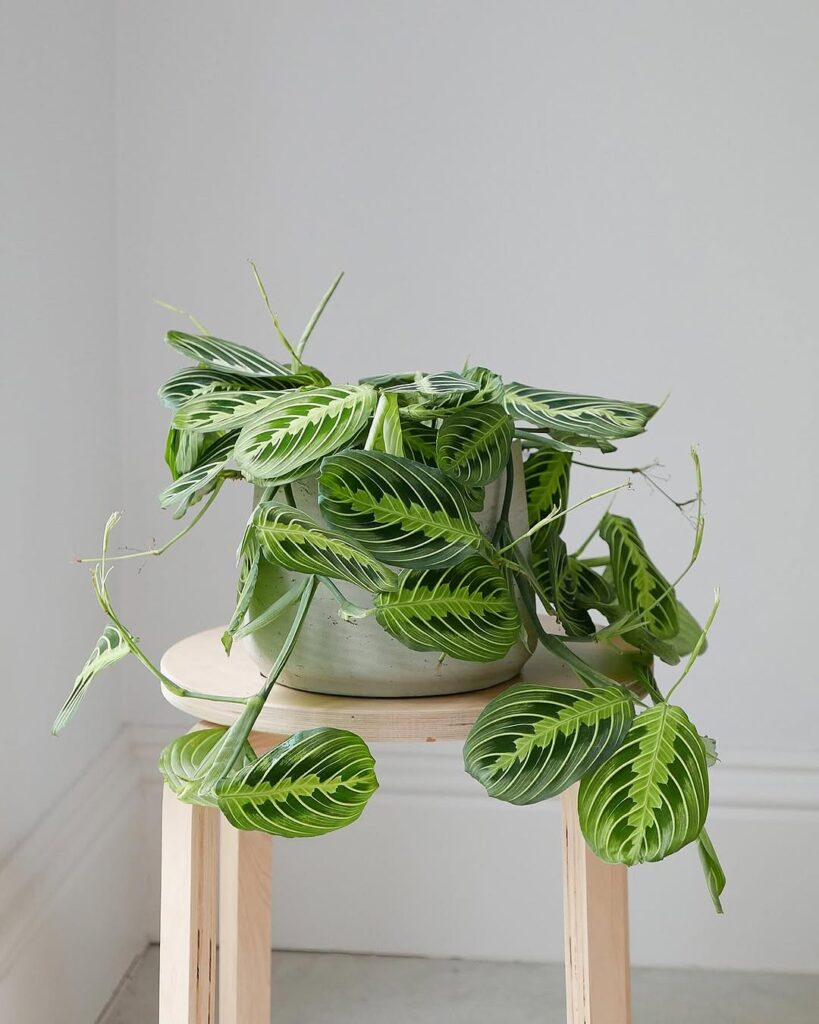
Prayer plants make stunning table centerpieces with their vibrant, patterned leaves that fold up at night. To create an eye-catching display, select a shallow ceramic bowl about 12 inches in diameter and fill it with well-draining potting mix.
Position your prayer plant slightly off-center, then surround it with small river rocks or glass beads. You’ll want to leave 2-3 inches of space between the plant and bowl’s edge for decorative elements. Add battery-operated micro lights beneath the foliage for evening ambiance.
For maintenance, mist the leaves twice weekly and rotate the bowl 45 degrees every few days to guarantee even growth and leaf movement.
Styling Prayer Plants on Floating Shelves
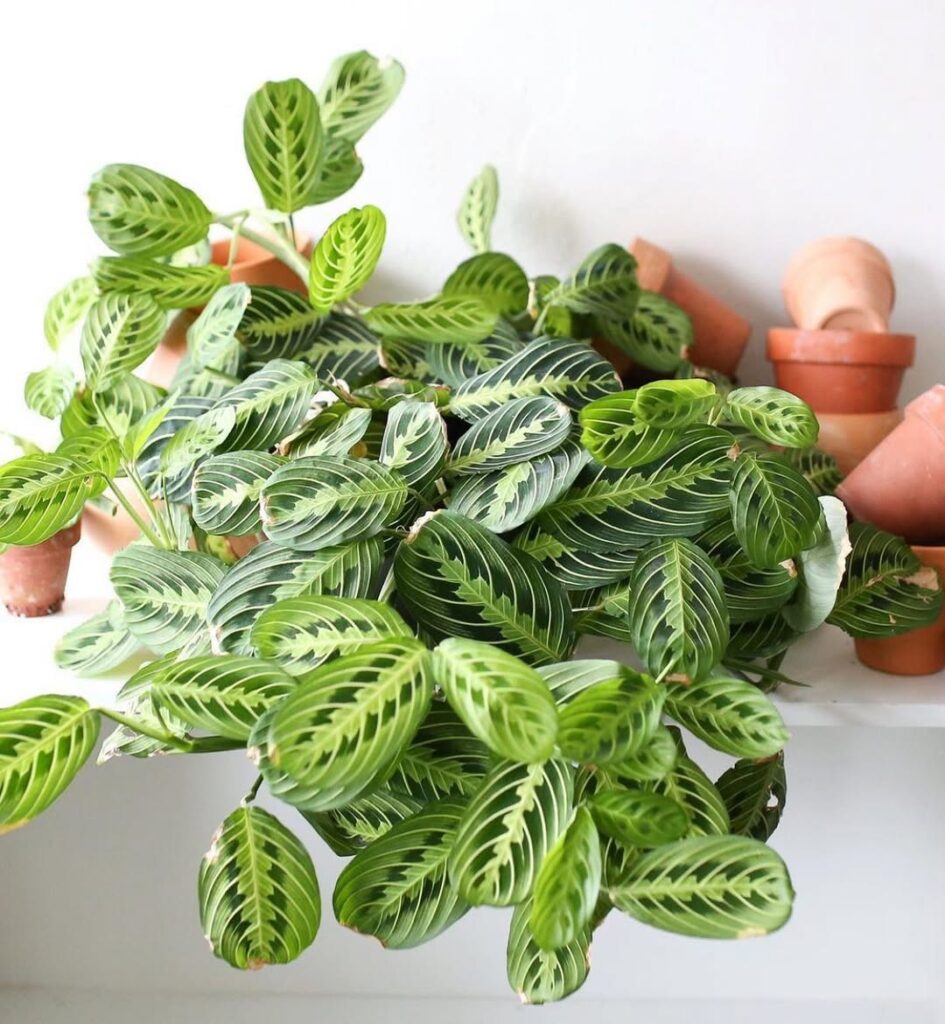
Three simple floating shelves can transform your prayer plant display into a striking vertical garden feature. Mount them 12-15 inches apart on your wall, ensuring each shelf can support at least 15 pounds.
Position your largest prayer plant on the bottom shelf, where its dramatic leaves can cascade downward. The middle shelf works perfectly for medium-sized varieties, while the top shelf’s ideal for compact specimens or trailing varieties that’ll create an eye-catching canopy effect.
Don’t forget to take into account light exposure – prayer plants thrive best on shelves that receive indirect light. You’ll want to rotate your plants weekly to maintain even growth patterns.
Using Decorative Stakes and Support Systems
While floating shelves showcase your plants beautifully, decorative stakes and supports can add both functional benefits and artistic flair to your prayer plant display.
You’ll find bamboo stakes work perfectly for prayer plants, ideally choosing 12-inch lengths for younger plants and 18-inch ones for mature specimens. Insert them at a 45-degree angle, about 2 inches from the plant’s base.
For an artistic touch, try copper-coated wire supports or decorative moss poles that allow climbing. You can also weave delicate fairy lights through metal plant supports, creating an enchanting evening display that highlights your prayer plant’s distinctive foliage patterns.
Incorporating Prayer Plants Into Plant Walls
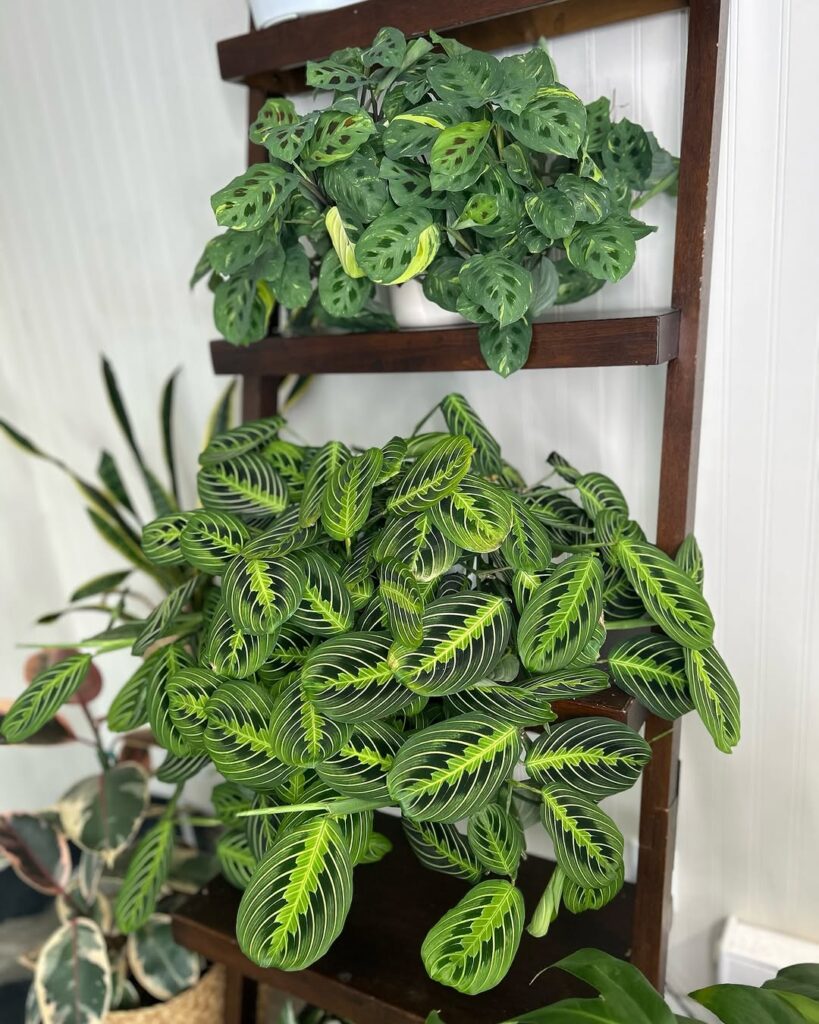
Creating an eye-catching plant wall with prayer plants starts with installing staggered shelving at 12-inch intervals, which provides ideal growing space while creating visual depth. You’ll want to combine different prayer plant varieties, such as Calathea medallion, Maranta leuconeura, and Stromanthe triostar, to achieve varying heights and leaf patterns. When mounting your plants, allow 18-24 inches between each specimen and install small trellis sections behind them for support as they mature and spread.
Staggered Shelving Display Techniques
Staggered shelving transforms an ordinary wall into a dynamic living tapestry when you incorporate prayer plants at varying heights and depths. Install shelves 12-15 inches apart vertically, with each shelf projecting 2-3 inches farther than the one above it.
Position larger prayer plants, like Maranta leuconeura, on lower shelves that extend 8-10 inches from the wall. Place smaller varieties, such as Calathea ornata, on upper shelves. You’ll want to alternate left and right placement to create visual balance.
Consider adding LED grow lights beneath each shelf to compensate for reduced natural light, especially for plants positioned toward the back.
Mix Prayer Plant Varieties
Building from individual shelves to full plant walls opens up endless creative possibilities for prayer plant displays. By combining different prayer plant varieties, you’ll create stunning visual interest through contrasting patterns and colors.
Mix bold Calathea orbifolia with delicate Maranta leuconeura, spacing them 8-12 inches apart. Add Stromanthe triostar at varying heights, letting their salmon-pink undersides create dynamic color shifts as leaves move throughout the day.
For ideal arrangement, place larger varieties like Ctenanthe burle-marxii at the bottom, medium-sized plants in the middle, and trailing varieties near the top. This creates a natural cascade effect while ensuring each plant receives appropriate light exposure.
Supporting Growth and Spacing
When you’re planning a prayer plant wall, proper spacing and support structures form the foundation for healthy growth. Position plants 8-12 inches apart to allow for spread, and install sturdy trellises or mesh panels that can support mature foliage.
Create tiers by mounting adjustable shelves 12-15 inches apart vertically. You’ll want to secure each prayer plant’s climbing stems using soft plant ties or twine, checking weekly for new growth that needs guidance.
For ideal viewing, place taller varieties like Calathea zebrina toward the back, with compact types like Maranta leuconeura in front. This arrangement creates depth while ensuring each plant receives adequate light and air circulation.
Choosing the Perfect Containers and Pots
Selecting the right container for your prayer plant sets the foundation for its health and visual appeal. Choose pots that are 1-2 inches wider than your plant’s root ball, ensuring adequate drainage holes at the bottom.
Terra cotta and ceramic containers work best, as they’re porous and help prevent root rot. You’ll want to avoid plastic pots, which can trap moisture and lead to fungal issues. For ideal growth, select containers 6-8 inches deep to accommodate the plant’s extensive root system.
Consider decorative cache pots that are 1-2 inches larger than your growing container, allowing you to showcase your prayer plant while maintaining proper drainage.
Arranging Prayer Plants at Different Heights
Creating visual interest with prayer plants starts with playing with different heights, from layered plant stands that showcase multiple specimens to floating shelves mounted at varying levels. You’ll find that hanging baskets add a dramatic vertical element, letting the distinctive leaves cascade downward for maximum impact. Whether you’re working with a multi-tiered plant stand, wall-mounted shelving, or macramé hangers, varying the heights of your prayer plants transforms an ordinary collection into an eye-catching display that maximizes your growing space.
Layered Plant Stand Displays
Layered plant stands transform prayer plants into living works of art by showcasing their distinctive foliage at multiple heights. Position your tallest stand, typically 36-48 inches, against a wall, then arrange medium and short stands in descending order to create visual depth.
You’ll want to place larger prayer plants, like Maranta leuconeura, on the bottom shelf where they’ll have room to spread. Reserve middle shelves, around 24 inches high, for medium varieties, and top shelves for compact specimens. Space your plants 8-12 inches apart to prevent overcrowding and guarantee each specimen’s dramatic leaf movements remain visible.
Floating Shelves for Height
When mounted strategically, floating shelves provide an elegant solution for displaying prayer plants at varying heights while maximizing vertical space. You’ll want to install shelves 12-18 inches apart vertically to allow proper growth room and create visual interest.
Choose sturdy floating shelves that can support at least 15 pounds each, accounting for pot weight and soil moisture. Install the lowest shelf 24 inches above furniture to prevent interference with seating or traffic flow.
For ideal plant health, position your shelves within 6 feet of a window, staggering them to guarantee each prayer plant receives adequate light without casting shadows on plants below.
Hanging Prayer Plant Baskets
Beyond mounting shelves, hanging baskets offer another eye-catching way to display your prayer plants at varying heights. Select macramé or woven baskets that measure 8-12 inches in diameter, ensuring proper drainage and weight distribution for your plants.
Install ceiling hooks 4-6 feet apart, using anchors rated for at least 20 pounds. You’ll want to position your baskets at staggered heights, typically 6-12 inches apart vertically, creating visual interest through layering.
For best results, choose trailing varieties like Maranta leuconeura ‘Kim’ or ‘Kerchoveana,’ as they’ll cascade beautifully from their suspended positions. Remember to rotate your baskets quarterly for even growth.
Building a Prayer Plant Corner Feature
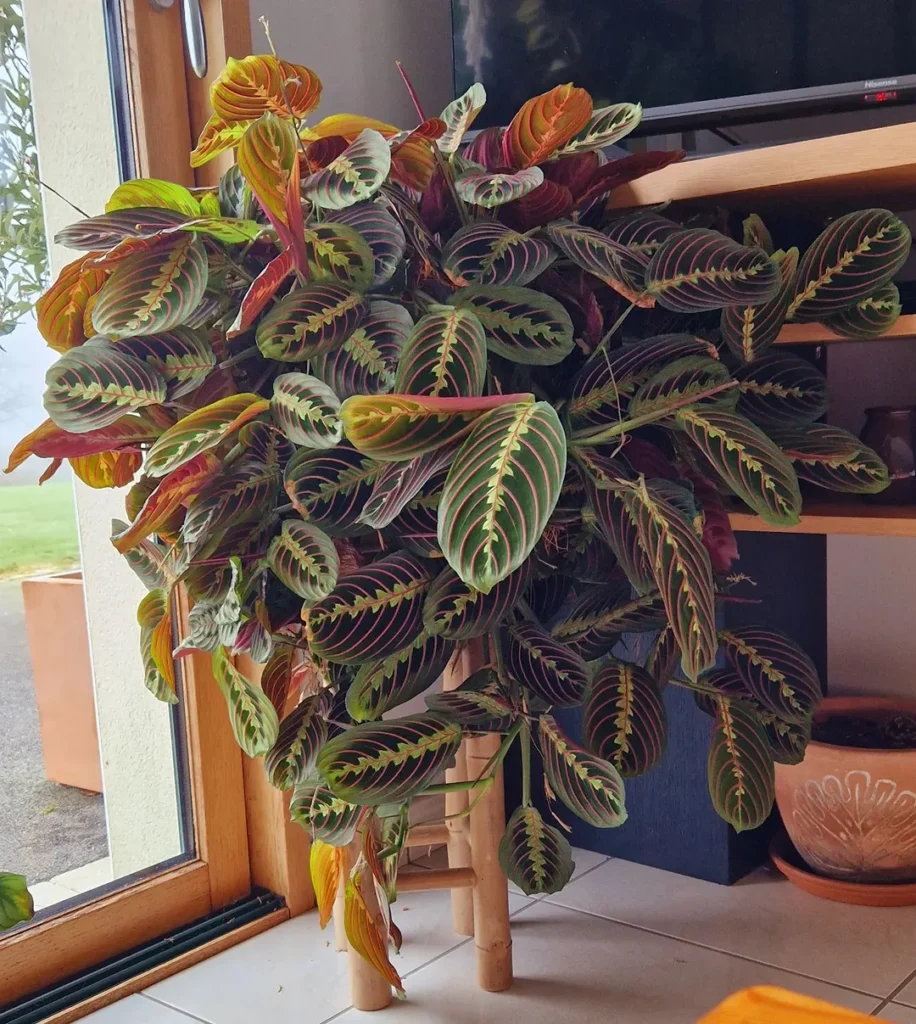
Creating a dedicated prayer plant corner transforms an ordinary space into a stunning focal point that celebrates these distinctive tropical beauties. Start by selecting a spot that receives indirect light, ideally 3-4 feet from an east-facing window.
Arrange plants at varying heights using 12-18 inch pedestals, wall-mounted shelves, or tiered plant stands. You’ll want to group 3-5 prayer plants together, spacing them 8-12 inches apart to allow for proper air circulation.
Add depth by incorporating moss poles for climbing varieties and placing larger specimens like Calathea orbifolia in the back. Consider installing LED grow lights 12-18 inches above the display for winter months.
Positioning Prayer Plants Near Mirrors for Impact
Strategic mirror placement can double the visual impact of your prayer plant display while making any room feel larger and more dynamic. Position your mirrors 12-18 inches behind prayer plants, angling them slightly upward at 15 degrees to capture the fullest view of the foliage.
You’ll want to place smaller plants (under 12 inches tall) on elevated surfaces like side tables or floating shelves, keeping them at eye level. For maximum effect, arrange 2-3 prayer plants of varying heights in front of a large mirror, spacing them 4-6 inches apart to create depth and allow their distinctive leaves to reflect clearly.
